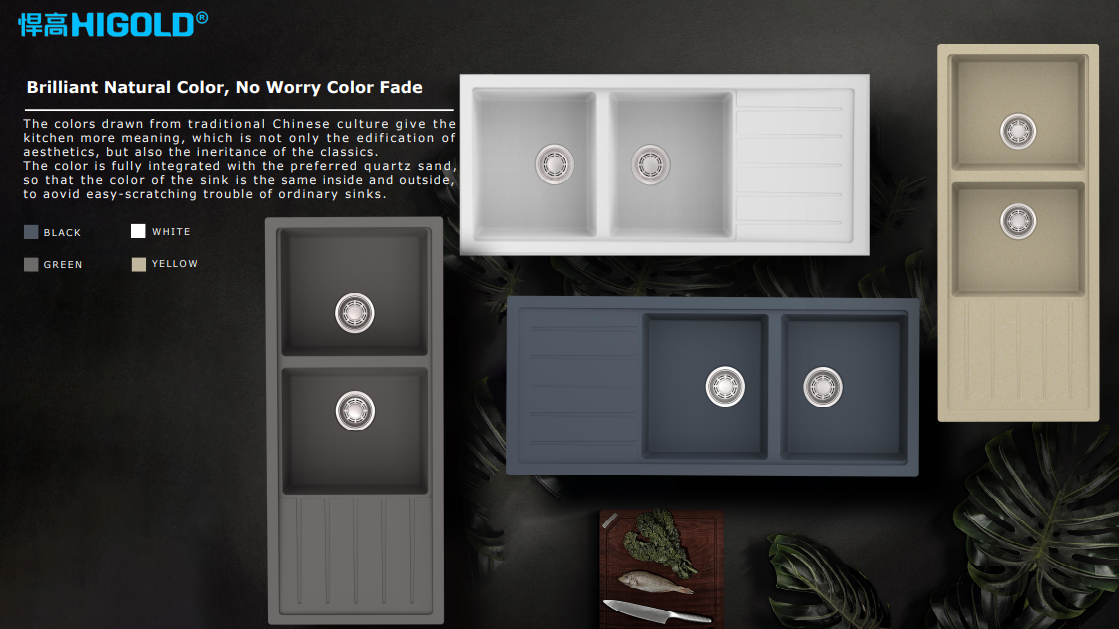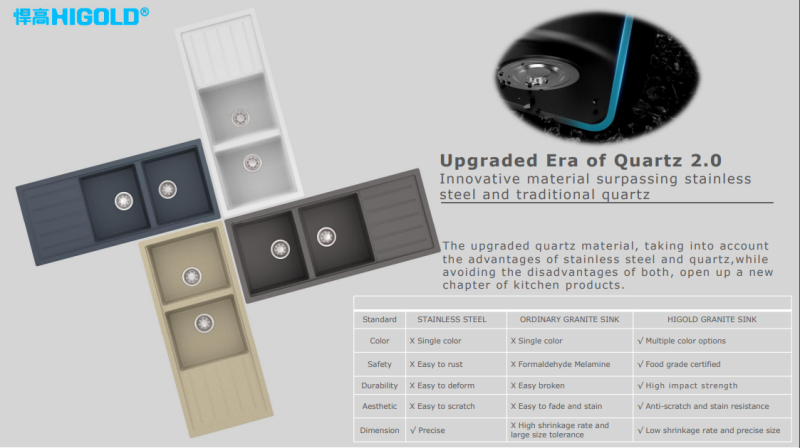In modern kitchens, the sink is one of the core facilities that is used every day. Whether it is washing ingredients, washing dishes, or disposing of kitchen waste, the sink assumes an important function. The life and performance of the kitchen composite sink are not only affected by factors such as its material and installation quality, but also have a close relationship with the caulking material around the composite sink. The caulking material of the sink is generally composed of sealants or silicones, which are used to prevent water leakage and protect the kitchen countertop and the area below from moisture.
However, many families often ignore the maintenance of the caulking around the sink in daily use. When the caulking material begins to age or fall off, it needs to be re-caulked. This article will discuss in detail the frequency, reasons, process and how to extend the service life of the kitchen composite sink re-caulking.

What is the role of kitchen composite sink caulking?
First of all, it is very important to understand why the kitchen composite sink needs caulking. The main functions of sink caulking are:
● Waterproof and leakproof: The caulking around the kitchen composite sink is usually located between the sink and the countertop, and these areas are susceptible to water flow. Appropriate caulking materials can effectively prevent moisture from leaking under the countertop, and prevent moisture from penetrating into the cabinets, wood or other decoration materials, causing rot, mold and even structural damage.
● Avoid bacterial growth: If the gaps around the kitchen composite sink are not properly sealed, they may become a breeding ground for bacteria and mold. Caulking materials can effectively prevent these problems and keep the kitchen clean and hygienic.
● Extend the service life of the countertop: Long-term moisture erosion of the kitchen countertop may cause damage or aging of the countertop surface. Caulking materials help protect the countertop material, prevent it from direct contact with water flow, and extend the service life of the countertop.
● Improve aesthetics: Appropriate caulking materials not only provide sealing functions, but also help improve the aesthetics of the joints between the composite sink and the countertop, avoiding problems such as dirt accumulation and yellowing.

What are the types of kitchen composite sink caulking materials?
There are many kinds of caulking materials for kitchen composite sinks. The common materials are mainly the following:
● Silicone Sealant: Silicone is the most common caulking material for kitchen composite sinks. It has good waterproofness, elasticity and durability. Silicone can adapt to different temperature changes and is suitable for use in humid kitchen environments. Its advantage is that it can fill larger gaps and is not easy to fall off.
● Polyurethane Sealant: Polyurethane sealant has strong adhesion and is suitable for larger gaps around kitchen composite sinks. It has excellent waterproof performance, wear resistance and heat resistance, and can be used for a long time in harsh kitchen environments.
● Acrylic Sealant: Acrylic sealant is relatively less used. Its water resistance and durability are not as good as silicone and polyurethane sealants, but it is cheaper and suitable for some simple kitchen composite sink caulking needs.
● Epoxy Resin: Epoxy resin is another strong sealing material. Although its application range is relatively limited, in some special cases, epoxy resin can be used as a caulking material with strong corrosion resistance.
Different materials have different service lives and effects. Silicone sealants are widely used for caulking around kitchen composite sinks because of their elasticity and waterproofness. Polyurethane and acrylic sealants are usually used for other types of sealing work. Although they can also be used for sink caulking, they may not be as good as silicone in terms of performance and durability.
How often does the kitchen composite sink caulking need to be re-caulked?
The service life of caulking materials varies depending on many factors. Generally speaking, the caulking materials around the sink need to be re-caulked about every 1 to 3 years. The specific time depends on the following factors:
● Frequency and intensity of use: If the kitchen composite sink is used frequently every day, and involves a lot of hot water, high-temperature pots, oil stains, and chemical cleaners, these will accelerate the aging process of the caulking material. Frequent high temperature and chemical contact may damage the structure of silicone or other caulking materials, causing the caulking materials to fail or fall off.
● Quality of caulking materials: High-quality caulking materials (such as high-grade silicone) tend to be more durable and can resist the erosion of time. Low-quality caulking materials may be more likely to discolor, fall off or crack, resulting in more frequent re-caulking.
● Environmental factors: Humidity and temperature changes in the kitchen can also affect the life of the caulking material. A high humidity and high temperature kitchen environment will accelerate the aging of the caulking material, resulting in a decrease in its durability. In addition, the accumulation of oil smoke and stains in the kitchen may also cause damage to the caulking material.
● Frequency of cleaning and maintenance: If the caulking around the kitchen composite sink is cleaned frequently and kept dry, the service life of the caulking material will be extended. Long-term uncleaning, oil accumulation and scale deposition may shorten the service life of the caulking material.
● Installation quality: The correct installation method will also affect the service life of the caulking material. If the caulking work is not done properly, or the caulking material is not properly filled into all the gaps, it is easy to cause water penetration and premature caulking.

What are the signs of re-caulking the kitchen composite sink?
Although the kitchen composite sink caulking can generally last for 1 to 3 years, there are some signs in actual use that indicate that it is time to re-caulk. These signs include:
● Water leakage: If leakage is found around the composite sink, it means that the caulking material has lost its sealing effect. At this time, you need to re-caulk to ensure that the sink can prevent water from penetrating under the countertop or into the cabinet to avoid water damage.
● Cracked or peeled caulking: As the use time increases, the caulking material may crack or fall off due to temperature changes, frequency of use, etc. Especially in places with large joints around the composite sink, once the caulking material is damaged, it must be re-caulked in time to prevent moisture penetration.
● Discoloration or yellowing of caulking material: If the caulking material changes color, especially the caulking material around white or light-colored sinks has yellow spots or mold, this is usually a sign of aging of the material. Discolored caulking material not only affects the appearance, but may also mean that the sealing is reduced and needs to be replaced in time.
● Stains are difficult to remove: After long-term use, if you find that the stains on the caulking are difficult to remove, or grease and scale are easily accumulated around the kitchen composite sink, it means that the sealing effect of the caulking material has weakened and needs to be re-caulked.

How to properly re-caulk the kitchen composite sink?
● Clean the old caulking material: First, you need to use a scraper or other tool to completely remove the old caulking material around the sink. The cleaning work needs to be done carefully to ensure that the old caulking material is completely removed and the gaps around the composite sink are clean and dry.
● Clean and dry the gaps: Wash around the gaps with a detergent to remove stains and residual grease. After that, wipe with a dry cloth to ensure that the gaps are dry so that the new caulking material can adhere better.
● Apply new caulking material: Choose a suitable caulking material, such as high-quality silicone sealant. Use a scraper or special tool to evenly apply the caulking material to the gap. Be careful not to apply too much material to avoid overflow, and at the same time ensure that the material fully fills each gap.
● Smooth the caulking surface: After applying the caulking material, gently wipe it with a damp cloth to ensure that the surface is flat and remove excess caulking. Professional tools can be used for trimming to achieve a neater seam effect.
● Wait for drying and curing: Depending on the type of caulking material, it is usually necessary to wait 24 to 48 hours until the new caulking material is completely dry and cured. At this time, please avoid contact with moisture on the kitchen composite sink to ensure that the caulking material adheres firmly.
Higold: Your Trusted Manufacturer of Kitchen Sinks
As a leading manufacturer of stainless steel kitchen sinks, Higold Group offers unparalleled quality and service. Our products are designed with durability, functionality, and aesthetics in mind, meeting the needs of both residential and commercial kitchens. With more than 7 years of successful partnerships with global brands like Costco, we provide reliable, high-quality products at low prices. For bulk orders and customized kitchen sink solutions, contact us for quotes and detailed pricing.


